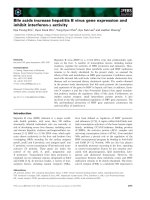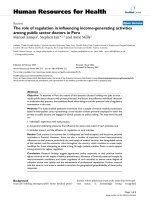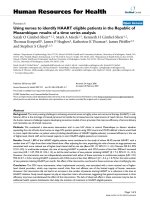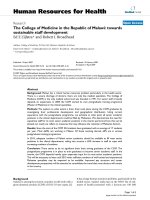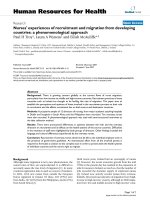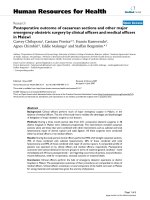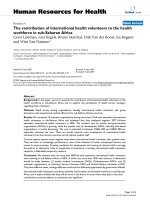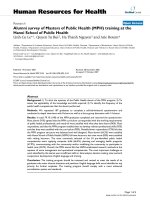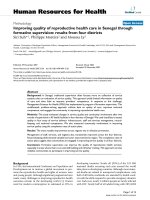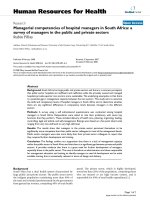Báo cáo sinh học: " Common Genotypes of Hepatitis B virus prevalent in Injecting drug abusers (addicts) of North West Frontier Province of Pakistan" doc
Bạn đang xem bản rút gọn của tài liệu. Xem và tải ngay bản đầy đủ của tài liệu tại đây (300.74 KB, 6 trang )
BioMed Central
Page 1 of 6
(page number not for citation purposes)
Virology Journal
Open Access
Research
Common Genotypes of Hepatitis B virus prevalent in Injecting drug
abusers (addicts) of North West Frontier Province of Pakistan
Muhammad Masroor Alam
1
, Sohail Zahoor Zaidi
2
, Shehzad Shaukat
1
,
Salmaan Sharif
1
, Mehar Angez
1
, Asif Naeem
1
, Shamim Saleha
3
,
Javed Aslam Butt
4
and Salman Akbar Malik*
5
Address:
1
Department of Virology, National Institute of Health, Islamabad, Pakistan,
2
Head of Department of Virology; Principal Investigator-
WHO Regional Reference Laboratory for Polio Eradication Initiative, National Institute of Health, Islamabad, Pakistan,
3
Research Student,
Department of Virology, National Institute of Health, Islamabad Pakistan,
4
Head of Department of Gastroenterology, Pakistan Institute of Medical
Sciences, Islamabad, Pakistan and
5
Head of Department of Biochemistry, Quaid-i-azam University, Islamabad, Pakistan
Email: Muhammad Masroor Alam - ; Sohail Zahoor Zaidi - ;
Shehzad Shaukat - ; Salmaan Sharif - ; Mehar Angez - ;
Asif Naeem - ; Shamim Saleha - ; Javed Aslam Butt - ;
Salman Akbar Malik* -
* Corresponding author
Abstract
Background: The epidemiological significance of Hepatitis B virus genotypes has been well
established and becoming an essential concern day by day however, much little is known about the
mixed infection with more than one Hepatitis B virus genotypes and their clinical relevance.
Methods: Intravenous drug abusers are considered as a major risk group for the acquisition and
transmission of blood borne infections like hepatitis B, however, in Pakistan, no such data has ever
been reported about the epidemiology of HBV and its genotypes in Injecting Drug Users. 250
individuals were analyzed for hepatitis B virus genotypes after prior screening with serological assay
for the detection of HBsAg.
Results: 56 (22.4%) individuals were found positive on ELSIA for HBsAg. The genotype distribution
was found to be as: genotype D, 62.5%; genotype A, 8.92% while 28.57% individuals were found to
be infected with a mixture of genotype A and D.
Conclusion: There is an urgent need of the time to develop public health care policies with special
emphasis towards the control of HBV transmission through high risk groups especially Injecting
Drug Users.
Background
Hepatitis B virus (HBV) infection is a well recognized and
major health problem leading to significant morbidity
and mortality worldwide especially in the developing
countries. Approximately, 2 billion people in the world
have been infected by HBV [1], 400 million of who are
chronic carriers [2]. The virus causes acute hepatitis of var-
ying severity [3] and persists in 95% of children and 2–10
% of adult patients [4] leading to chronic liver disease, cir-
rhosis, hepatocellular carcinoma [5] and even fulminant
Published: 28 June 2007
Virology Journal 2007, 4:63 doi:10.1186/1743-422X-4-63
Received: 11 May 2007
Accepted: 28 June 2007
This article is available from: />© 2007 Alam et al; licensee BioMed Central Ltd.
This is an Open Access article distributed under the terms of the Creative Commons Attribution License ( />),
which permits unrestricted use, distribution, and reproduction in any medium, provided the original work is properly cited.
Virology Journal 2007, 4:63 />Page 2 of 6
(page number not for citation purposes)
hepatitis [6]. In Pakistan, HBV infection rate is increasing
day by day. The reason may be the lack of proper health
facilities or poor economical status and less public aware-
ness about the transmission of major communicable dis-
eases like Hepatitis B virus, Hepatitis C virus and Human
Immunodeficiency Virus.
The seropositivity rate of Hepatitis B surface antigen
(HBsAg) varies in the different regions of the world with a
considerable low rate in the developed countries like
0.6% in Wales, England, 1.2 % in USA. However, the
developing countries depicts a high alarming rate report-
ing 19.6% in Egypt, 2–10% in India, 3.5% in Palestine
and 1.6–7.7% in Brazil [7-11]. Viral hepatitis is endemic
in Pakistan with an estimated rate of 3–4% [12]. Multiple
studies have been conducted regarding prevalence rate of
HBV infection based on various population groups in
Pakistan. All such studies present a varying rate of infec-
tion based on the study design, population selected, diag-
nostic assays and demographical and epidemiological
variation. According to various study groups, the HBV
prevalence rate has been reported as 2–10% among
healthy blood donors; 5–9% among health care person-
nel; 3.6–18.66% among the general population; 3.16%
among the pregnant women; 10–20% in patients with
provisional diagnosis of hepatitis and 3.16–10.4% among
professional blood donors [13]. These reports highlight
the lack of a country wide epidemiological studies that
can present the overall disease status in the whole country.
Hepatitis B virus is a genetically heterogenous hepadnavi-
rus possessing a partially double stranded DNA genome
with an estimated rate of 1.4 – 3.2 × 10
-5
nucleotide sub-
stitution per site per year [14]. Additionally, the virus rep-
licates by using its RNA polymerase which lacks the proof
reading activity resulting in nucleotide misincorporations
and an established genetic variability which gives rise to
the well recognized subtypes and genotypes of the virus.
Based on an inter-group divergence of 8% or more in the
complete genomic sequence, HBV has been classified into
8 different genotypes having distinct geographical distri-
bution [15].
Genotype A can be regarded as pandemic but is most com-
monly found in Northern Europe, North America and
Central Africa, while genotype B predominates in Asia
(China, Indonesia and Vietnam). Genotype C is found in
the Far East in Korea, China, Japan and Vietnam as well as
the Pacific rim and Island Countries, while genotype D,
which is also more or less pandemic, is found in the Med-
iterranean countries, the Middle East extending to India,
North America and parts of the Asia-Pacific region. Geno-
type E is related to Africa while genotype F is found pre-
dominately in South America, including among
Amerindian populations, and also Polynesia. Genotype G
has been found in North America and Europe while the
most recently identified genotype H has been reported
from America [16].
Since the discovery of HBV subtypes, their impact on the
natural course of infection has been studied mainly in the
South-East Asia where HBV is hyper endemic with prevail-
ing genotypes B and C. The clinical significance of differ-
ent HBV genotypes has become increasingly recognized in
patients with acute and chronic infection. The course of
HBV infection depends on several factors such as host
genetic factors, age and genetic variability of the virus
[17,18]. Genotype C induces a more severe disease, has
higher scores for fibrosis and is more prevalent in cirrhotic
patients as compared to genotype B [19]. Seroconversion
from HBeAg to anti-HBeAg positivity occurs much earlier
in genotype B than genotype C carriers [20]. Genotype C
is found to have lower HBV DNA level than genotype A, B
and D in the HBeAg positive patients [21]. Taken together,
these studies suggest well established pathogenic, epide-
miological, clinical and therapeutic differences among
HBV genotypes. However, the epidemiology of mixed
HBV genotype infections is very less understood [22].
The epidemiological studies of various research groups
indicated the predominant prevalence of genotype B and
genotype C in South East Asian countries while the HBV/
D is mainly found in Central Asia [23-25]. Apart from the
initial studies reported mainly from Japan and China, it is
now known that seven (A-G) HBV genotypes can be
found in Asia. There are many studies focusing the preva-
lence of multiple genotype infections. In Pakistan, no
such data is available up to now indicating the prevalence
of HBV infected population with more than on genotype.
Most HBV infections result from sexual activity, injection-
drug use, or occupational exposure [26]. Intravenous drug
use and needle sick injuries have been identified as com-
mon modes of HBV transmission in the developing coun-
tries [27]. Therefore, the present study was conducted to
assess the prevalent HBV genotypes in a well-known high
risk group of Hepatitis B infection; Intra venous drug users
(IDUs).
Results
Out of the total 250 individuals, 56 (22.4%) subjects were
found to be serological positive for HBsAg. All samples
were further processed for genotyping. It was found that
majority of the IDUs (35 out of 56) were infected with
genotype D, making it the most frequently found geno-
type with prevalence rate of 62.5%. 15 (8.92%) individu-
als were found to be positive for genotype A while 16
(28.57%) drug addicts were found to be positive for gen-
otype mixture A and D [Fig. 1].
Virology Journal 2007, 4:63 />Page 3 of 6
(page number not for citation purposes)
Discussion
In Pakistan, very little data is available about the IDUs
reflecting an alarming situation of high infection rates
among this highly vulnerable class of the society.
Although most of these studies represent the data about
HCV, for example, IDUs in Karachi have very high rates of
hepatitis C (94%) which has also been documented in
other reports as well [29,30]. In few studies, HBV status
has been assessed like; 7.5% IDUs were found to be posi-
tive for Hepatitis B surface antigen in Karachi reported by
the very recent joint study conducted by Enhanced HIV/
AIDS Control Program, Government of Sindh Pakistan
and United Nations Office for Drug Control and Crime
Prevention (UNODC), 2007. According to a survey
regarding prevalence of viral hepatitis among the high risk
groups like frequent blood recipients and IDUs is 13.05%
while 25.67% patients of Chronic Liver disease harbor
Hepatitis B virus [31]. Inspection of 3 private health clin-
ics in Hafizabad, Pakistan exposed disposable syringes
and needles, used primarily for vitamin B complex, chlo-
roquine, and penicillin, soaked in a bowl of tepid water.
Extrapolation of study findings suggested 800 new cases
of HCV and 109 HCV-related deaths in Hafizabad each
year. Although this is referred to HCV but keeps equal
importance as the risk of both HBV and HCV share equal
importance using shared syringes. In another report, 350
IDUs were selected from a cohort study in Amsterdam of
whom 70% injected recently, the prevalence of HIV, HBV
and HCV were 31%, 68% and 65% respectively [32]. Also,
awareness about hepatitis B and hepatitis C as a result of
sharing needles and syringes is less (60%) [33].
According to the quantitative data on injection usage and
unsafe injection practices, such as the reuse of unsterilized
syringe or needles, obtained by reviewing the published
articles and unpublished reports of the WHO, 18 studies
presented convincing evidence on the association of
unsafe injection practices and the transmission of blood
borne viruses such as hepatitis B and C, Ebola, Lassa virus
infections and malaria [34]. A simple mass-action model
was applied to world census which showed that about 8–
16 million HBV, 2.3–4.7 million HCV, and 80,000–
160,000 HIV infections may result from unsafe injections
each year [35].
Well established chains of transmission for blood-borne
infections such as hepatitis and HIV exist in Pakistan. For
example: needle sharing is common among the injecting
drug users
36
. In 1999, UNDCP and UNAIDS Pakistan
jointly studied the injecting drug users in Lahore, Paki-
stan's second largest city, finding an alarming high rate of
hepatitis infection among them. Pakistan is a major tran-
sit and consumer country for opiates from neighboring
Afghanistan, the world's largest producer of opium. As a
result of the high levels of opium production in the region
over the past two decades, Pakistan has now one of the
highest addiction rates in the world [36]. According to the
statistics provided by Anti-Narcotic Force, out of 4 million
drug addicts in Pakistan, 3% are women, 12% of whom
inject the drug which lead to high risk of Hepatitis B/C
and HIV/AIDS.
Estimations of a local NGO working for the well-being of
addiction free population in Pakistan reports a total of
about 4.1 million drug addicts, of which 2 million are
chronic heroin addicts. Since the early 1980s, political
and economic changes within the region have facilitated a
dramatic increase of poverty and social problems linked
to the illegal production and marketing of opiates. Paki-
stan itself has succeeded in supply reduction; nevertheless,
the NWFP is seriously affected. The main factors contrib-
uting to the problem of drug addiction are: high level of
illiteracy and lack of social and life skills; daily easy avail-
ability of a deadly substance with analgesic and relaxing
properties considering it a potential source of relief for all
kinds of stress. In Pakistan, 53% of heroin addicts start
experimenting with drugs at the age of 15–25 years [37].
NWFP has a striking figure of intravenous drug abusers
locating in various regions of the province. Peshawar is
located at the gateway of the transit trade route from
Afghanistan easy availability of drugs at cheap prices are a
permanent risk for Peshawar's youngster's and Pakistan's
young population as a whole. Recent outbreak investiga-
tions of HBV in Sindh province, where the major etiolog-
ical cause of the outbreak, was found to be the
Intravenous drug injections among addicts signifies the
IDUs as a major and potential transmission source of
infection among the population.
In Pakistan, we have recently conducted a preliminary
research project on prevalent genotypes of HBV in Paki-
2.5% agarose gel showing genotype specific bands in patients infected with hepatitis B virusFigure 1
2.5% agarose gel showing genotype specific bands in patients
infected with hepatitis B virus. M: 50 bp marker; Lane 2–3:
HBV genotype A specific 68 bp band; Lane 4–5: HBV geno-
type D specific 119 bp band; Lane 6–10: genotype A and D
specific 68 bp and 119 bp bands in patients with mixed geno-
type infections.
Virology Journal 2007, 4:63 />Page 4 of 6
(page number not for citation purposes)
stan (under publication) including general randomized
population irrespective of major risk groups and have
reported the prevalence of mixed genotypes infection in
only 3% of total study subjects. However, here we have
found that 28.57% IDUs are infected with multiple geno-
types indicating very frequent horizontal transmission
among the intravenous drug users.
The initial studies on HBV genotyping revealed that geno-
types B and C are the most prevalent genotypes in Asian
regions. It was because of the fact that all such studies were
reported from Japan and China where genotype B and C
are the most prevalent genotypes. Later on, it was found
that all the seven HBV genotypes can be found in Asia
[38]. For instance, the predominant genotypes in India are
Genotype A and D [39]. The predominant HBV genotypes
in Afghanistan were found to be genotype D [40]. Simi-
larly, Zeng reported 1.6% patients infected with multiple
HBV genotypes [41].
Mixed infection with more than one HBV genotypes is of
growing interest from the epidemiological, virological,
clinical and therapeutic points of view. Research studies
on such multiple infections are the vital requirement to
understand the events of recombination that has been
reported between different HBV genotypes [42,43]. The
multiple HBV genotypes determined in intravenous drug
users (IDU) at Taiwan were as: mixed genotype A and B in
18 (5.5%); genotype B and C in 30 (9.2%); genotype B
and D in 1 (0.3%); genotype A and C in 1 (0.3%); and
mixed infections of genotype A, B, and C in 3 (0.9%) [44].
In Belgium, the HBV genotyping studies revealed multiple
genotype infection rate of genotype A and genotype D to
be 8% and 9% for blood donors and gastroenterology
patients [45]. In Shenzhen (China), HBV infection rate
with multiple genotypes was found to be 31% [46].
There are several studies reporting the existence of multi-
ple HBV genotypes in various countries but mostly repre-
sent the figure related to patients irrespective of high risk
groups like IDUs. For example, a study conducted on the
patients from four regions of china reported that that
mixed genotypes B and C was in 50.0% of the patients
suggesting the mixed infection might lead to a severe
damage of the liver tissue [47]. 26% of liver transplant
patients at London were reported to harbor multiple gen-
otypes of HBV [48]. In Tibet, the predominant HBV geno-
type is HBV C/D hybrid virus [49]. Hannoun et al. (2002)
found 8% of HBV patients with genotype mixture [50];
Toan et al., (2006) found that chronic patients are more
prone to be infected with more than one HBV genotype
than acutely infected patients [38]; genotypes mixture in
HBV patients is also common in Thailand [51]; 16% HBV
cases were positive for HBV genotype mixture in France
[52].
We have found 28.57% patients infected with multiple
(more than one) HBV genotypes. It has already been doc-
umented that the HBsAg prevalence rate in pregnant
women was 2.5% in Pakistan, out of which 17% and 61%
were HBeAg and anti-HBeAg positive thus indicating the
vertical transmission a less important cause of HBV trans-
mission [53]. The present study reflects the importance of
horizontal transmission as IDUs have several risky behav-
iors like sharing needles, cotton, syringes, multiple injec-
tions from a single drug source and jerking. The
importance of such sources to identify remained the limi-
tations of the study.
Conclusion
This study brings basic information on the HBV positivity
rate and genotype distribution among intravenous drug
abusers of North West Frontier province of Pakistan. A
possible proof of correlation with clinical and epidemio-
logical characteristics will require further analysis. In con-
clusion, unsafe injections among drug addicts as well as
medical practices occur routinely in Pakistan, implying a
significant potential for the transmission of any blood
borne pathogen. Unsafe injections currently account for a
significant proportion of all new hepatitis B and C infec-
tions. This situation needs to be addressed immediately,
as a political and policy issue, with responsibilities clearly
defined at the country and community levels. Drug
addicts should be at a prime importance as the targets of
disease prevention and control programs in Pakistan as
they do not stay permanently at a particular or specified
area and are considered as mobile source of disease trans-
mission.
Methods
Study Design
This study was completed during January 2005 to August
2006 at Serology laboratories, Department of Virology,
National Institute of Health (NIH), Islamabad after
receiving approval from the Research committee of NIH.
The study samples were collected from various locations
of Peshawar, the capital of NWFP. Based on the facts that
the intravenous drug abusers are highly vulnerable for
blood borne infections and Peshawar is harboring a high
number of drug addicts, the present study was designed to
collect epidemiological information and molecular based
analysis regarding hepatitis B virus, its current picture and
disease status among the drug addicts living in North West
frontier Province (NWFP) of Pakistan. 252 individuals
were randomly selected. The study subjects were only
males selected from all age groups ranging 12–65 years.
Serological Testing
Blood sample was taken from all individuals after getting
verbal informed consent. 8cc of venous blood was col-
Virology Journal 2007, 4:63 />Page 5 of 6
(page number not for citation purposes)
lected in a sterile vaccutainer and was referred to Serology
laboratory, Department of Virology, NIH where centrifu-
gation was done to separate sera. Sera were stored at -
20°C until further processing. The individuals were
screened for serological testing of HBV surface antigen
(HBsAg) using AxSym HBsAg MEIA, Abbott Laboratories,
IL, USA.
Molecular analysis
Serological positive samples for HBsAg were further proc-
essed for HBV genotypes by the same methodology using
genotype specific primers as described previously
28
.
Briefly, DNA was extracted from 100 µl serum sample of
110 HBsAg positive patients using Biospin Blood
Genomic DNA Mini-Prep Kit (Bioer Technology Co., Ger-
many) according to the manufacturer's protocol, eluted in
70 µl buffer and stored at -20°C. Genotyping was per-
formed using 50 µl reaction mixture was used containing
1X buffer, 20 µM primers, 2.4 µM dNTPs and 1.5U Taq
polymerase. 40 cycles was performed at 95°C for 1 min,
50°C for 30 sec, 72°C for 30 sec. The amplified product
was run on 2.5% agarose gel and visualized under U.V
illuminator.
Competing interests
The author(s) declare that they have no competing inter-
ests.
Authors' contributions
SSZ and SAM designed the Research project and gave a
critical view of manuscript writing, JAB and SS helped in
collecting the samples. MMA and SS collected the epide-
miological data and wrote the manuscript. AN analyzed
the data statistically. SS and MA performed the serological
and molecular assays. All the authors have read and
approved the final manuscript.
References
1. Zuckerman JN, Zuckerman AJ: Current topics in hepatitis B.
Journal of infections 2000, 41(2):130-136.
2. Lee WM: Hepatitis B infection. New England Journal of Medicine
1997, 337:1733-1745.
3. Heerman KH, Gerlich WH, Michael C, Schaefer S, Thomssen R:
Quantitative detection of heopatitis B virus DNA in two
international reference plasma preparartions. Journal of Clini-
cal Microbiology 1999, 37(1):68-73.
4. Bowyer SM, Sim GM: Relationship within and between the gen-
otypes of Hepatitis B virus at point across the genome: foot-
prints of recombination in certain isolates. Journal of General
Virology 2000, 81(2):379-392.
5. Abe A, Kazuaki I, Take AT, Junko K, Nooki K, Satoshi T, Mkoto Y,
Michinori K: Quantification of Hepatitis B virus genomic DNA
by Real-Time detection. Journal of Clinical Microbiology 2000,
37(9):2899-2903.
6. Mahoney FJ: Update on diagnosis, management, and preven-
tion of hepatitis B virus infection. Clinical Microbiology Reviews
1999, 12:351-366.
7. Yassin K, Awad R, Tebi Aj, Queder A, Laaser U: Prevalence and
risk factors of HBsAg in Gaza: implication for preventionand
control. Journal of Infections 2002, 44(4):252-256.
8. Arboleda M, Castilho MC, Fonseca JC, Albuquerque BC, Saboia RC,
Yoshida CF: Epidemiological aspects of hepatitis B and D virus
infection in the northern region of Amazonas, Brazil. Trans
Roy Soc Trop Med Hyg 1995, 89:481-483.
9. Passos AD, Gomes UA, Figueiredo JF, do Nascimento MM, de
Oliveira JM, Gaspar AM, Yoshida CF: Influence of migration on
the prevalence of serologic hepatitis B markers in a local
rural community, analysis of prevalence by birth place.
Revista De Saude Publica 1993, 27:30-35.
10. El-Sayed HF, Abaza SM, Mehanna S, Winch PJ: The prevalence of
hepatitis B and C infections among immigrants to a newly
reclaimed area endemic for Schistosoma mansoni in Sinai,
Egypt. Acta Tropica 1997, 68:229-237.
11. Chowdhury A, Santra A, Chaudhuri S, Ghosh A, Banerjee P, Mazum-
der DN: Prevalence of hepatitis B infection in the general
population: arural community based study. Trop Gastroenterolo
1999, 20(2):75-77.
12. Andre F: Hepatitis B epidemiology in Asia: the Middle East
and Africa. Vaccine 2000, 18(Suppl 1):S20-2.
13. HBV and HCV review article by JCPSP. 2000, 12(6):368-371.
14. Orito E, Mizokami M, Ina Y, Moriyama EN, Kameshima N, Yamamoto
M, Gojobori T: Host dependent evolution and a genetic classi-
fication of the hepadnavirus family based on nucleotide
sequence. Proceedings of National Academy of Sciences USA 1989,
86:7059-7062.
15. Okamoto H, Tsuda F, Sakugawa H, Sakugawa H, Sastrosoewignjo RI,
Imai M, Miyakawa Y, Mayumi M: Typing Hepatitis B virus by
homology in nucleotide sequence: comparison of surface
antigen subtypes. Journal of General Virology 1988, 69:2575-2583.
16. Kramvis A, Kew M, Francois G: Hepatitis B virus genotypes. Vac-
cine 2005, 23:2409-2423.
17. Gunther S, Fischer L, Pult I, Sterneck M, Will H: Naturally occur-
ring variants of hepatitis B virus. Advances in Virus Research 1999,
52:25-137.
18. Hunt CM, McGill JM, Allen MI, Condreay LD: Clinical relevance of
hepatitis B viral mutations. Hepatology 2000, 31:1037-44.
19. Kao JH, Chen PJ, Lai MY, Chen DS: Hepatitis B genotypes corre-
late with clinical outcomes in patients with chronic hepatitis
B. Gastroenterology 2000, 118:554-559.
20. Sumi H, Yokosuka O, Seki N: Influence of Hepatitis B virus gen-
otypes on the progression of chronic type B liver disease.
Hepatology 2003, 37:19-26.
21. Westland C, Delaney W, Yang H: Hepatitis B virus genotypes
and virologic response in 694 patients in phase III studies of
adefovir dipivoxil1. Gastroenterology 2003, 125:107-116.
22. Chen BF, Chen PJ, Jow GM, Sablon E, Liu CJ, Chen DS, Kao JH: High
prevalence of mixed genotype infections in hepatitis B virus
infected intravenous drug users. J Med Virol 2004, 74(4):536-42.
23. Zhu B, Luo K, Hu Z: Establishment of a method for classifica-
tion of HBV genome and its application. Zhonghua Shiyan He
Linchuang Bingduxue Zazhi 1999, 13:309-313.
24. Liu Cj, Kao Jh, Chen PJ, Lai My, Chen DS: Molecular epidemiology
of hepatitis B virus serotypes and genotypes in Taiwan. J of
biomed Sciences 2002, 9(2):166-170.
25. Kato H, Ruzibakiev R, Yuldasheva N, Hegay T, Kurbanov F, Achund-
janov B, Tuichiev L, Usuda S, Ueda R, Mizokami M: Hepatitis B virus
genotypes in Uzbekistan and validity of two different sys-
tems for genotyping. Journal of Medical virology 2002, 67:477-483.
26. Harpaz R, Von Seidlein L, Averhoff FM, et al.: Transmission of hep-
atitis B virus to multiple patients from a surgeon without evi-
dence of inadequate infection control. N Engl J Med 1996,
334:549-554.
27. Custer B, Sullivan SD, Hazlet TK, Iloeje U, Veenstra DL, Kowdley KV:
Global epidemiology of hepatitis B virus. Journal of clinical Gas-
troenterology 38(10 Suppl):S158-S168.
28. Naito H, Hayashi S, Abe K: Rapid and specific genotyping system
for hepatitis B virus corresponding to six major genotypes by
PCR using type specific primers. Journal of Clinical Microbiology
2001, 39(1):362-364.
29. United Nations Office on Drugs and Crime: World Drug Report, Statis-
tics, United Nations 2005, II: [ 2005/
volume2web.pdf].
30. United Nations Drug Control Programme Global Assess-
ment Programme on drug Abuse, Narcotics Control Divi-
sion A-NFGoP: Drug Abuse in Pakistan. In Results from the year
2000 National Assessment New York, United Nations; 2002.
31. [
].
Publish with BioMed Central and every
scientist can read your work free of charge
"BioMed Central will be the most significant development for
disseminating the results of biomedical research in our lifetime."
Sir Paul Nurse, Cancer Research UK
Your research papers will be:
available free of charge to the entire biomedical community
peer reviewed and published immediately upon acceptance
cited in PubMed and archived on PubMed Central
yours — you keep the copyright
Submit your manuscript here:
/>BioMedcentral
Virology Journal 2007, 4:63 />Page 6 of 6
(page number not for citation purposes)
32. Van Ameijden EJ, Van den Hoek JA, Mientjes GH, Coutinho RA: A
longitudinal study on the incidence and transmission pat-
terns of HIV, HBV and HCV infection among drug users in
Amsterdam. Eur J Epidemiol 1993, 9(3):255-62.
33. Kuo I, Hasan S, Galai N, Thomas DL, Zafar T, Ahmed MA, Strathdee
SA: High HCV seroprevalnce and HIV drug use risk behav-
iours among injection drug users in Pakistan. Harem reduction
Journal 2006, 3:26.
34. Simonsen L, Kane A, Lloyd J, Zaffran M, Kane M: Unsafe injections
in the developing world and transmission of bloodborne
pathogens: a review. Bull World Health Organ 1999,
77(10):789-800.
35. Kane A, Lloyd J, Zaffran M, Simonsen L, Kane M: Transmission of
hepatitis B, hepatitis C and human immunodeficiency
viruses through unsafe injections in the developing world:
model-based regional estimates. Bull World Health Organ 1999,
77(10):801-7.
36. 2001 [
]. ODCCP report
37. DOST Welfare Foundation, Pakistan.
.
38. Toan NL, Song LH, Kremsner PG, Duy DN, Binh VQ, Koeberlein B,
Kaiser S, Kandolf R, Torresi J, Bock CT: Impact of Hepatitis B
virus genotypes and genotype mixtures on the course of liver
disease in Vietnam. Hepatology 2006, 25:1375-1384.
39. Thakur V, Guptan RC, Kazim SN, Malhotra V, Sarin SK: Profile,
spectrum and significance of HBV genotypes in chronic liver
disease patients in the Indian subcontinent. Journal of Gastroen-
terology and Hepatology 2002, 17(2):165-170.
40. Amini- Bavil-Olyaee S, Alavian SM, Adeli A, Sarrami-Forooshani R,
Sabahi F: Hepatitis B virus genotyping, core promoter and
precore/core mutations among afghan patients infected
with hepatitis B: a preliminary report. Journal of Medical Virology
2006, 78:358-364.
41. Zeng GB, Wen SJ, Wang ZH, Yan L, Sun J, Hou JL: A novel hepatitis
B virus genotyping system by using restriction fragment
length polymorphism patterns of S gene amplicons. World J
Gastroenterol 10(21):3132-6. 2004 Nov 1
42. Chen BF, Kao JH, Liu CJ, Chen DS, Chen PJ: Genotypic dominance
and novel recombinations in HBV genotype B and C co-
infected intravenous drug users. J med Virol 2004, 81:379-392.
43. Kato H, orito E, Gish RG, Bzowel N, Newson M, Sugauchi F, Suzuki
S, Ueda R, Miyakawa Y, Mizokami M: Hepatitis B e antigen in sera
from individuals infected with hepatitis b virus of genotype
G. Hepatology 2002, 35:922-929.
44. Chen BF, Chen PJ, Jow GM, Sablon E, Liu CJ, Chen DS, Kao JH: High
prevalence of mixed genotype infections in hepatitis B virus
infected intravenous drug users. J Med Virol 2004, 74(4):536-42.
45. Micalessi MI, De Cock L, Vranckx R: Hepatitis B virus (HBV) gen-
otyping in Belgian patients with chronic HBV infection. Clin
Microbiol Infect 2005, 11(6):499-501.
46. Dai JY, Shi ZL, Dai Y, Du H, Chen DH, Wang SY: Genotyping of
HBV DNA in Shenzhen and clinical manifestations. Zhonghua
Gan Zang Bing Za Zhi 2004, 12(4):199-200.
47. Zhu B, Luo K, Hu Z: Establishment of a method for classifica-
tion of HBV genome and it's application. Zhonghua Shi Yan He
Lin Chuang Bing Du Xue Za Zhi 1999, 13(4):309-13.
48. Girlanda R, Mohsen AH, Smith H, Sablon E, Yuen MF, O'Grady J,
Muiesan P, Rela M, Heaton N, Norris S: Hepatitis B virus geno-
type A and D and clinical outcomes of liver transplantation
for HBV-related disease. Liver Transpl 2004, 10(1):58-64.
49. Cui C, Shi J, Hui L, Zhuoma XX, Quni XX, Tsedan XX, Hu G: The
dominant hepatitis b virus genotype identified in Tibet is C/
D hybrid. J Gen Virol 2002, 83:2773-2777.
50. Hannoun C, Krogsgaard K, Horal P, Lindh M: Genotype mixtures
of hepatitis B virus in patients treated with interferon. Journal
of Infectious Diseases 2002, 15:752-759.
51. Jutavijittum P, Jiviriyawat Y, Yousukh A, Kunachiwa W, ToriYama K:
Genotypes of Hepatitis B virus among voluntary blood
donors in northern Thailand. Hepatology Research 2006:26.
52. Halfon P, Bourliere M, Pol S, Benhamou Y, Ouzan D: Multicenter
study of Hepatitis B virus genotypes in France: Correlation
with liver fibrosis and hepatitis B e antigen status. Journa of
Viral Hepatology 2006, 13(5):329-325.
53. Abbas Z, Jafri W, Shah SH, Khokhar N, Zuberi SJ: Pakistan Society
of Gastroenterology. PSG consensus statement on manage-
ment of hepatitis B virus infection-2003. J Pak Med Assoc 2004,
54:150-158.
